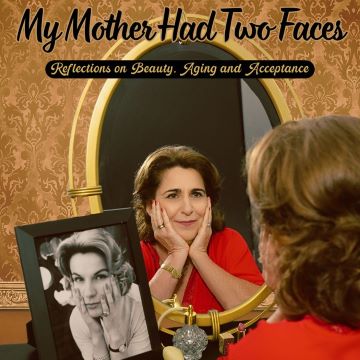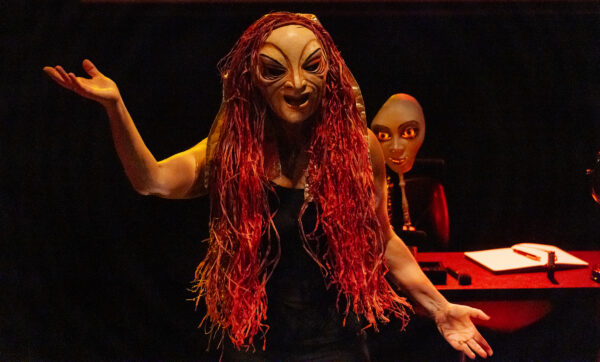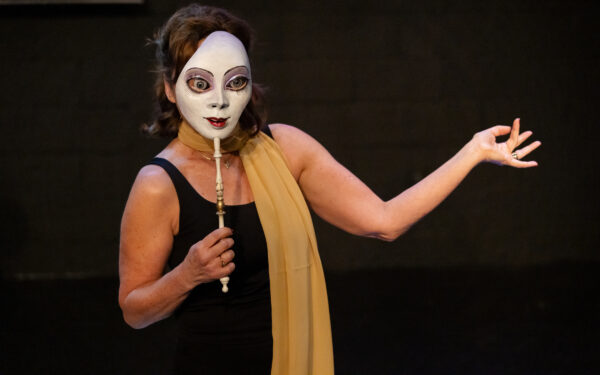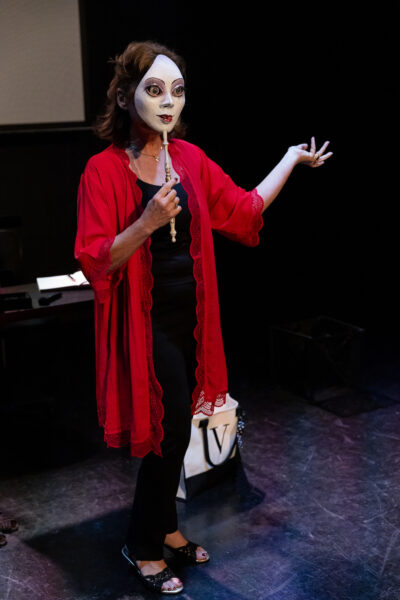HER MOTHER, HERSELF
It’s a truism that many women fear “becoming their mother,” and that’s certainly the implied starting point of Karin Trachtenberg’s one-woman show, My Mother Had Two Faces. The performance opens with a recording of Marlene Dietrich singing “Mutter, Kannst Du Mich Vergeben” (“Mother, Can you Forgive Me”) — an interesting choice in that the focus of the action in the show revolves around a daughter’s effort to forgive her mother.
With the sparest of sets — a vanity table with a mirror, an array of jewelry and cosmetics, a mask of a woman’s made-up face — we learn about Trachtenberg’s mother, her daily routine of moisturizing, plucking, tweezing, highlighting, and concealing to create a flawless face. We learn as well about her mother’s obsession with household cleanliness, her scrubbing, waxing, dusting, and vacuuming. The flip side of that obsession is her rage when a small child — e.g., young Trachtenberg — spills juice or stains her clothing, or for that matter is restless at bedtime, robbing her mother, exhausted from housework, of needed sleep. These two manifestations of Trachtenberg’s mother are depicted with masks by Eric Bornstein.
A screen at the back of the small stage offers some projections of glamorous European women of the 1950s and 1960s — Dietrich, Greta Garbo, Zsa Zsa Gabor — and we learn that Trachtenberg’s mother was Swiss by birth. (Trachtenberg’s childhood involved yearly visits to Switzerland to spend time with her grandparents.) But the most frequent image on the screen is a projection of an oval mirror evoking the Disney version of Snow White. The mirror-image holds a projection of Trachtenberg playing a different character from the one we see on the stage, a character who challenges Trachtenberg with probing questions that push her to acknowledge the ways in which she has replicated — or mirrored — elements of her mother’s behavior she doesn’t like. This is a clever device that invites us to wonder: Is the woman in the mirror Trachtenberg herself — her other face? Or is she someone completely different — her therapist perhaps?
When Trachtentberg’s mother moves to an assisted living facility, Trachtenberg has the job of clearing out her mother’s belongings. Among the jewelry and luxurious wardrobe items, she discovers diaries. Too frightened to examine them at first, she sets them aside until after her mother’s death, and then slowly begins to examine them, searching for, and finding, confirmation of her memories of abuse.
Trachtenberg shares stories of her mother — her travel to the United States to pursue a theatrical career, her unplanned pregnancy and subsequent marriage, her anxiety about losing her husband’s affections while pregnant with a second child — as Trachtenberg examines herself in her own metaphorical mirror to acknowledge her own attitudes about her appearance and her parenting. Examination of the diaries confirms memories she had doubted — was her mother really abusive?
But as a Buddhist, Trachtenberg knows that simply confirming that her mother was abusive is not her goal. She is looking for a way to love her mother, and to confirm that her mother loved her. Trachtenberg’s use of masks and mirrors and her open vulnerability in portraying her own conflicting emotions are effective as she sets out to resolve these questions.
Ultimately, Trachtenberg does find closure, and yet, I came away with questions that begged for answers. A sentence or two explaining the outcome of her parents’ marriage, for example, would have been helpful, as they seemed to be on the verge of a divorce that never quite happened. Did they split up and then reconcile? A sentence or two about how or if Trachtenberg’s mother abused her second child, Trachtenberg’s younger brother, would have provided some context; we wonder whether the mother resents the pregnancy that forced her into a marriage she may not have been ready for, for example.
Likewise, some speculation about why her mother was so obsessed with creating a flawless exterior, whether of her face of her body or her home, would have been useful — was she trying to atone for something? Reassure herself about the rightness of her difficult choices? And while we hear a lot about Trachtenberg’s relationship with her mother as a small child, we don’t have a sense on whether or how that relationship evolved as Trachtenberg moved into adulthood and became a parent herself (other than her surprise at her mother’s warm grandparenting). The performance as it stands provides a lot of information about her mother’s obsession with perfection; some of those references could be cut to provide space for further context and might take the play in a deeper direction.
photos courtesy of the artist
My Mother Had Two Faces
reviewed on March 3, 2024 at The Rockwell, 255 Elm Street in Somerville, MA
75 minutes
heads next to New York City for the United Solo Festival on March 14, 2024 (tickets HERE)
and then to the Edinburgh Fringe Festival
for more info, visit Karen Trachtenberg




